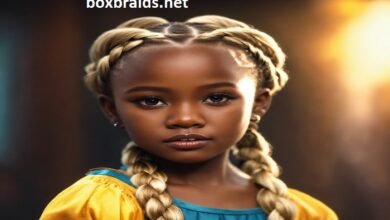Mastering Hair Braids: A Comprehensive Guide to Styles, Techniques, and Care

Hair braids have been a timeless and versatile hairstyle choice across various cultures and generations. From intricate traditional styles to modern, edgy designs, hair braids offer endless possibilities for expression and creativity. Whether you’re looking to enhance your everyday look or make a bold statement for a special occasion, mastering hair braids can elevate your style game. This comprehensive guide delves into the world of hair braids, exploring their history, different types, benefits, and essential tips for creating and maintaining beautiful braids. Whether you’re a beginner eager to learn or an enthusiast seeking to refine your techniques, understanding the nuances of hair braids will help you achieve stunning and long-lasting results.
The Rich History of Hair Braids
Hair braids boast a rich and diverse history that spans cultures and centuries. Originating as a practical solution to manage long hair, hair braids evolved into symbols of identity, status, and community. In African cultures, intricate hair braids often signify social status, age, and tribal affiliation. Similarly, in Viking societies, braids were not only fashionable but also practical for warriors, preventing hair from obstructing their vision in battle. Native American tribes also embraced hair braids as a way to represent heritage and personal achievements. Over time, hair braids have transcended cultural boundaries, becoming a global phenomenon celebrated for their beauty and versatility. Understanding the historical significance of hair braids adds depth to their modern-day appeal, highlighting their enduring legacy in the world of fashion and personal expression.
Exploring Different Types of Hair Braids
The world of hair braids is incredibly diverse, offering a multitude of styles to suit various preferences and occasions. Classic styles include the three-strand braid, French braid, and Dutch braid, each offering a unique look and complexity. The fishtail braid, known for its intricate and elegant appearance, is perfect for both casual and formal settings. Cornrow braids, tightly woven close to the scalp, are a staple in many cultures and offer a sleek, stylish finish. Box braids, characterized by their sections and versatility, allow for creative styling and are a popular choice for protective hairstyles. Additionally, modern variations like the waterfall braid and rope braid provide fresh twists on traditional designs. Each type of hair braid offers distinct aesthetics and benefits, allowing individuals to express their style while enjoying the functional advantages of braiding.
Benefits of Choosing Hair Braids
Opting for hair braids comes with a host of benefits that make them a favored hairstyle choice for many. One of the primary advantages of hair braids is their ability to protect natural hair from damage caused by environmental factors and daily styling. Braids help minimize breakage and split ends, promoting healthier hair growth. Additionally, hair braids offer versatility, allowing individuals to experiment with different styles without committing to long-term changes. They are also ideal for busy lifestyles, as braids require minimal daily maintenance once styled. Moreover, hair braids can enhance the appearance of thin or unruly hair, adding volume and structure. Whether for practical reasons or aesthetic appeal, the benefits of hair braids make them an attractive option for maintaining healthy, stylish hair.
How to Choose the Right Hair Braid Style for You
Selecting the perfect hair braid style involves considering several factors to ensure it complements your hair type, face shape, and personal style. Start by assessing your hair texture and thickness; certain braid styles work better with specific hair types. For example, thick, curly hair may hold intricate braids like fishtail or box braids more effectively, while fine hair might benefit from simpler styles like the three-strand braid or French braid. Additionally, consider the maintenance required for each style and how it fits into your daily routine. Your face shape also plays a role in choosing a braid that enhances your features; for instance, side braids can soften angular faces, while central braids can highlight symmetrical features. Personal style preferences, whether you favor classic elegance or modern trends, will further guide your choice. By thoughtfully selecting the right hair braid style, you can achieve a look that is both flattering and manageable.
Step-by-Step Guide to Creating Basic Hair Braids
Creating basic hair braids is a fundamental skill that forms the foundation for more intricate styles. To begin, ensure your hair is detangled and free of knots by gently brushing it. Divide your hair into three equal sections, holding the right section in your right hand, the left section in your left hand, and keeping the middle section stationary. Cross the right section over the middle section, then the left section over the new middle section. Repeat this pattern, alternating sides, until you reach the end of your hair. Secure the braid with a hair tie or elastic band. For a polished look, you can gently tug at the braid to loosen it and add volume. Practicing this basic technique will enable you to create a variety of braid styles with confidence. Mastering the fundamentals of hair braids opens the door to exploring more complex and creative braiding techniques.
Popular Hair Braid Trends in 2024
In 2024, hair braids continue to evolve, embracing both timeless styles and innovative trends. Among the most popular trends is the halo braid, which wraps around the head like a crown, offering an ethereal and romantic appearance. Another trending style is the braided ponytail, combining the simplicity of a ponytail with the elegance of intricate braiding. Multi-strand braids, incorporating multiple braids of varying sizes and textures, provide a bold and dynamic look. Additionally, accessorizing hair braids with beads, ribbons, and metallic threads adds a personalized and stylish touch. The resurgence of traditional cultural braids, adapted with modern twists, highlights the growing appreciation for diverse braiding techniques. These trends reflect the versatility and enduring popularity of hair braids, making them a staple in contemporary hairstyling.
Hair Braids for Different Hair Types
Hair braids are adaptable to a wide range of hair types, each benefiting from tailored braiding techniques. For straight hair, braids like the classic three-strand or French braid can add texture and dimension, creating a sleek and polished look. Wavy hair pairs well with loose fishtail braids or bohemian-inspired styles, enhancing natural waves and adding a touch of elegance. Curly hair thrives with protective styles such as box braids or cornrow braids, which help manage curls and reduce frizz. Coily hair can be beautifully showcased with intricate braided patterns, including micro braids or twist braids, highlighting the hair’s natural texture and versatility. Regardless of your hair type, there is a hair braid style that can accentuate your features and complement your unique hair characteristics, ensuring a flattering and comfortable fit.
Maintaining and Caring for Your Hair Braids
Proper maintenance and care are essential for ensuring the longevity and health of your hair braids. To start, keep your scalp clean by gently washing it with a diluted shampoo solution, allowing moisture to reach your natural hair. Regular moisturizing is crucial; apply a lightweight oil or braid spray to prevent dryness and keep your braids looking fresh. Protect your hair braids at night by wrapping them in a silk or satin scarf or using a silk pillowcase to minimize frizz and preserve the style. Avoid excessive manipulation or pulling on the braids to prevent breakage and discomfort. Additionally, be mindful of product buildup by occasionally rinsing your scalp and hair with water or a clarifying solution. By following these maintenance tips, you can enjoy well-maintained hair braids that remain stylish and healthy over time.
The Cultural Significance of Hair Braids
Hair braids hold profound cultural significance, serving as expressions of identity, heritage, and tradition across various communities. In many African cultures, braiding styles convey social status, tribal affiliation, and personal milestones, with each pattern and technique carrying unique meanings. Native American tribes use braids to represent spiritual beliefs and community bonds, often incorporating symbolic elements into their designs. In Scandinavian history, braids were associated with warriors and royalty, signifying strength and nobility. Additionally, braids play a vital role in modern cultural movements, celebrating diversity and embracing traditional techniques within contemporary fashion. Understanding the cultural significance of hair braids fosters appreciation for their rich heritage and the diverse narratives they embody, highlighting their importance beyond mere aesthetics.
DIY Hair Braids vs. Professional Braiding Services
Choosing between DIY hair braids and professional braiding services depends on your skill level, time commitment, and desired outcome. DIY hair braids offer flexibility and cost-effectiveness, allowing you to experiment with different styles at your convenience. With numerous tutorials and resources available, beginners can learn basic braiding techniques and gradually advance to more complex styles. However, achieving intricate and polished hair braids may require practice and patience. On the other hand, professional braiding services provide expertise and precision, ensuring flawless and long-lasting results. Stylists can create customized braid styles tailored to your hair type and personal preferences, often incorporating accessories and advanced techniques. Whether you prefer the hands-on approach of DIY or the expertise of a professional, both options offer unique advantages for achieving beautiful hair braids.
Conclusion
Hair braids are more than just a hairstyle; they are a versatile form of self-expression, a protective method for maintaining healthy hair, and a celebration of cultural heritage. From the simplicity of a basic three-strand braid to the complexity of intricate patterns, hair braids offer endless possibilities for creativity and personalization. Understanding the different types of hair braids, their historical significance and the best practices for creating and maintaining them empowers you to embrace this timeless trend with confidence. Whether you’re exploring hair braids for the first time or looking to refine your skills, this comprehensive guide provides the knowledge and inspiration needed to achieve stunning and lasting results. Embrace the art of hair braids and let your hair tell your unique story.
FAQ
1. How long do hair braids typically last?
Hair braids can last anywhere from a few days to several weeks, depending on the type of braid and how well you maintain them. Protective styles like box braids or cornrows can last up to eight weeks with proper care, while simpler braids may need to be refreshed more frequently.
2. Can I sleep with my hair in braids?
Yes, you can sleep with your hair in braids. To protect your braids and reduce frizz, wrap your hair in a silk or satin scarf or use a silk pillowcase. This helps maintain the integrity of your braids and prevents tangling while you sleep.
3. How do I prevent hair breakage when braiding?
To prevent hair breakage when braiding, ensure your hair is well-moisturized and avoid braiding too tightly, which can cause stress on your strands. Use gentle techniques and consider using a leave-in conditioner or braid spray to keep your hair healthy and hydrated.
4. What tools do I need to create hair braids at home?
Creating hair braids at home requires minimal tools. Basic items include a wide-tooth comb or brush for detangling, hair elastics or clips to section your hair, and optionally, a mirror to help with visibility. For more intricate styles, you might use braiding products like gels or sprays to hold the braids in place.
5. Are hair braids suitable for all hair types?
Yes, hair braids are suitable for all hair types. Whether you have straight, wavy, curly, or oily hair, some braid styles and techniques can complement your natural texture. Choosing the right braid style for your hair type ensures a comfortable fit and enhances the overall look.




